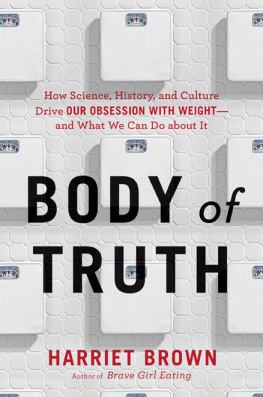First published 1999 by Transaction Publishers
Published 2017 by Routledge
2 Park Square, Milton Park, Abingdon, Oxon 0X14 4RN
711 Third Avenue, New York, NY 10017, USA
Routledge is an imprint of the Taylor & Francis Group, an informa business
Copyright 1999 by Taylor & Francis.
All rights reserved. No part of this book may be reprinted or reproduced or utilised in any form or by any electronic, mechanical, or other means, now known or hereafter invented, including photocopying and recording, or in any information storage or retrieval system, without permission in writing from the publishers.
Notice:
Product or corporate names may be trademarks or registered trademarks, and are used only for identification and explanation without intent to infringe.
Library of Congress Catalog Number: 2012021208
Library of Congress Cataloging-in-Publication Data
Interpreting weight : the social management of fatness and thinness / Jeffery Sobal and Donna Maurer, editors.
p. cm. -- (Social problems and social issues)
Includes bibliographical references and index.
1. Obesity--Social aspects. 2. Food--Social aspects. 3. Nutrition--
Social aspects. I. Sobal, Jeffery, 1950- II. Maurer, Donna, 1961-
RA645.O23I55 2012
362.196398--dc23
2012021208
ISBN 13: 978-0-202-30578-3 (pbk)
Contents
Donna Maurer and Jeffery Sobal
Douglas Degher and Gerald Hughes
Gina Cordell and Carol Rambo Ronai
Leanne Joanisse and Anthony Synnott
Gwen E. Chapman
Susan Haworth-Hoeppner
Jeffery Sobal, Caron Bove, and Barbara Rauschenbach
Rebecca J. Lester
Karen Honeycutt
Elizabeth Ransom
Thomas F. Cash and Robin E. Roy
Jeanine C. Cogan
What is too fat? What is too thin? Interpretations of body weight vary widely across and within cultures. Meeting cultural weight expectations is a major concern for many people because failing to do so may incur dire social consequences, such as difficulty in finding a romantic partner or even finding adequate employment. Attaining an ideal weight is a social achievement. Without cultural expectations and sanctions, and without the pressures of social interactions with family, friends, co-workers, and acquaintances, body weight would only be a health issue. While socially constructed standards of acceptable body weight may seem immutable, they are re-created continuously through social interaction. Social interactions can perpetuate or transform social expectations about body weight.
Understanding social constructions of body weight requires insight regarding how people develop and use constructions in their daily lives. While structural conditions and cultural environments make important contributions to weight constructions, the chapters in this book focus on the social processes in which people engage while they interpret, negotiate, resist, and transform cultural definitions and expectations. As such, most of the chapters in this volume borrow from and contribute to a symbolic inter actionist perspective.
THE SOCIAL CONSTRUCTION OF BODY WEIGHT AND SYMBOLIC INTERACTIONISM
Social constructionist thinking occurs in many forms, with symbolic interactionism as a core theoretical perspective. Symbolic interactionists are concerned with the production of meanings and the creation and social management of selves. In addition, they examine how people construct definitions and preferences in the course of human interaction. This approach contrasts with a social facts or objectivist perspective, which focuses on documenting and explaining the existence of social phenomena primarily through quantitative analyses and interpretations (Ritzer 1975). This brief overview addresses some of the basic concepts used by authors in this volume.
HUMAN AGENCY, MEANING, AND INTERPRETATION
A central concept in symbolic interactionism (as well as in this book) is human agency: each persons potential capacity to make choices and to affect others actions, despite the constraints imposed by large, pervasive structural realities. While agency can be a problematic theoretical variable (Alexander 1987; Emirbayer and Mische 1998), it is key to symbolic interactionism and other related perspectives (including many forms of social constructionism, social phenomenology, and humanist sociology) because it suggests that human actions are not determined only by social structure. Humans are creative beings fully capable of initiating and carrying out positive social changes.
Exerting agency, however, necessitates an understanding of the social environment, which is discovered through the interpretation of meanings. Meanings do not reside within individuals; they are social phenomena made possible by a common language. Symbolic interactionism sees meanings as social products, as creations that are formed in and through the defining activities of people as they interact (Blumer 1969:5). Meanings become solidified through habituated social interaction and often become taken for granted (Berger and Luckmann 1966). Hence, people often act upon these meanings as if they are objectively real. As W. I. Thomas wrote, If men define situations as real, they are real in their consequences (1966:301). If people define themselves as overweight with reference to a shared cultural ideal, they are likely to act on the basis of this definition, by perhaps dieting, wearing certain clothes, or acting as they believe an overweight person should act. When people regard socially constructed meanings as facts, they sustain and perpetuate these meanings as seemingly objective reality.
Shared meanings do not necessarily perpetuate cultural beliefs and standards, however. When people share a social world, they can negotiate joint lines of action that generate new meanings. These emergent meanings can have behavioral consequences. As social meanings about ideal body weight shift, people may interpret their social environments and personal experiences differently. For example, within certain social groups, fatness may shift from a pejorative to a neutral term, leading their members to define themselves differently and to act in accordance with these new definitions. Accepting an emergent definition of fat acceptance may lead a person to abandon dieting rituals and to focus on personal qualities and characteristics other than body weight.SELF AND IDENTITY
Symbolic interactionism also deals with the creation and re-creation of the self. All interactionists... agree that self is not an object that has inherent meaning, but is a construct that is given meaning through an actors choices, mediated by the relationships, situations, and cultures in which she or he is embedded (Fine 1993:78). The self is not innate or static, but an emergent social product created through interacting with others (Charon 1998). Like all other social objects, the self is socially defined; hence ones self is, in part, created by others in the social environment. These social responses contribute to a persons identity, how one sees oneself and how others view and categorize one as being a particular









